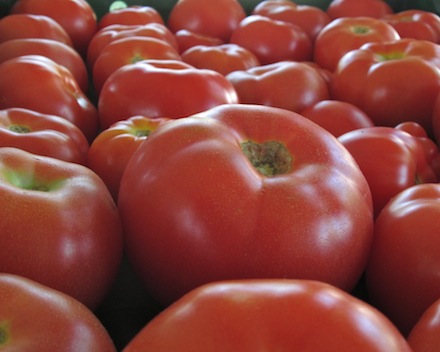
AgriCulture bloggers Peter Davies and Mark Scherzer are the owners of Turkana Farms in Germantown, NY. This week, Mark's column was inspired by a recent story in The New York Times: No, I won't bore you with yet another analysis of Justice Roberts's decision upholding the constitutionality of the Affordable Care Act. That's yesterday's news. Today the momentous news is that we now know why the modern tomato stinks. There is almost universal agreement that the tomatoes you get in supermarkets and on your fast food burgers are insipid, if not utterly flavorless. As The Times points out, most people have blamed these qualities on their being picked green and hard in order not to get blemished when shipped. Or on their being refrigerated, which tends to destroy tomato texture and flavor. Or on their being bred to have tough skins for shipping, rather than flavor.

Botanists have now determined the problem lies much more in the modern tomato's lovely, uniformly scarlet color. Decades ago, tomato breeders discovered a gene mutation that caused the tomatoes to ripen evenly into a particularly appealing hue, and since then they have bred that mutation into almost all modern tomato varieties. The problem is, they've now discovered, that gene mutation also turns off other genes that cause the tomato fruits themselves to produce sugars (as opposed to relying solely on the plants' leaves for those sugars) and carotenoids, which are nutritive chemicals found in plant pigments. The particular carotenoid in tomatoes is called lycopene, which is believed to be associated with reduced risk for various types of cancer as well as being an immune booster. Lycopenes are found in apricots, papayas, grapefruit, and watermelon as well as in red tomatoes. Low sugar and lycopene production in the fruit mean that even when the modern breeds of tomatoes are vine-ripened, they end up being flavor-deficient and lower in nutritional value. The desire for uniform color is something that we've been trained as consumers to want through supermarket programming. Not only tomatoes but also apples and other fruits have to pass a visual test to be sold in supermarkets, an artificial one based on impossible perfection.

Our artificially created visual expectations can have distinctly negative effects. When we first started raising heirloom varieties, like the Black Krim, a variety I love even more than Brandywines, we repeatedly made the mistake of postponing picking them until the whole fruit turned purple, rather than picking them while the shoulders were still dark green, because we understood that tomatoes are supposed to look uniform in color. It took a while to accustom ourselves to the idea that it was not just OK, but preferable to pick these tomatoes when their shoulders are dark green. The shoulders are indeed ripe and tasty at that stage, and if we wait until they turn purple the bottoms will typically start to rot out. Artificial consumer expectations make for considerable challenge when marketing heirloom varieties that ripen unevenly and are motley in appearance. Peter recalls an incident about seven or eight years ago that illustrates these challenges. He arrived at a local farmstand we were supplying with a basket of our heirloom tomatoes and watched as they were set out on the counter. Just after he made the delivery some highly coiffed and well-outfitted women arrived and began picking them up, holding them to the light and examining them as if they were diamonds. They were apparently dismayed by the uneven colors and less than perfect shapes. Peter saw the proprietor of the stand mouth to them "wait until tomorrow." She was alluding to another local supplier who specialized in picture-perfect tomatoes artistically arranged.

We realized that the visual was triumphing here over flavor, as it has at the supermarket. That was the last batch we ever delivered to that stand. In recent experiments, the botanists whose research had uncovered the mechanism by which the sugar and carotenoid production had been turned off manipulated the gene to turn them back on. They found that the tomatoes produced 20% more sugars and 20-30% more carotenoids. We can assume (though USDA rules prohibit tasting experimental produce) that those tomatoes with the extra sugars and carotenoids had a lot more flavor. So can we now expect in next year's seed catalogs yet even newer varieties of tomato, with names like Sugar Girl and Purple Lycopia, with the uniform color mutation bred in, but the sugar and carotenoid producing characteristics magically restored? If so, might there be even newer "unanticipated consequences" from all that manipulation that we won't discover for several more years? Might we not be safer just reconciling ourselves to the sometimes-motley appearance of the heirloom varieties, and even the bit of waste that may come from cutting off the unevenly ripened shoulders, in exchange for the fantastic flavors we know lie within? At Turkana Farms, we opt for flavor and safety over picture-perfect visuals, and so we are voting for the tried-and-true heirlooms. We're still a few weeks away from getting ripe fruits from our tomato plants, but I'm already salivating at the image, in my mind, of the BLTs and tomato plates that are to come. –Mark Scherzer









